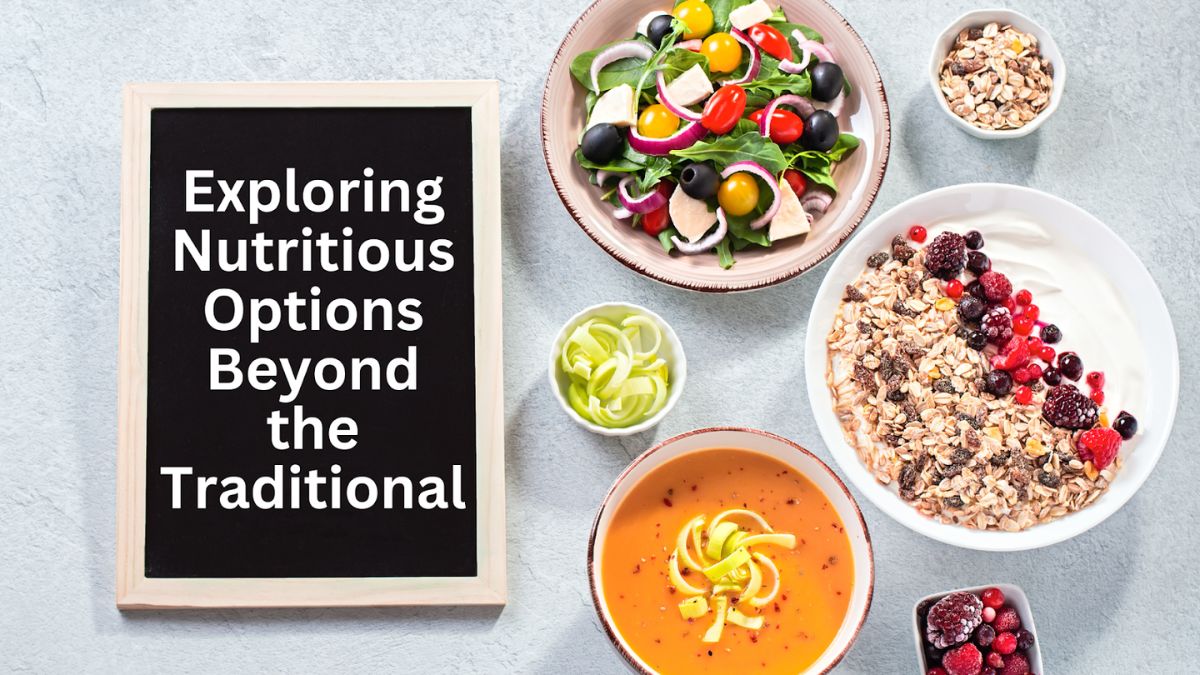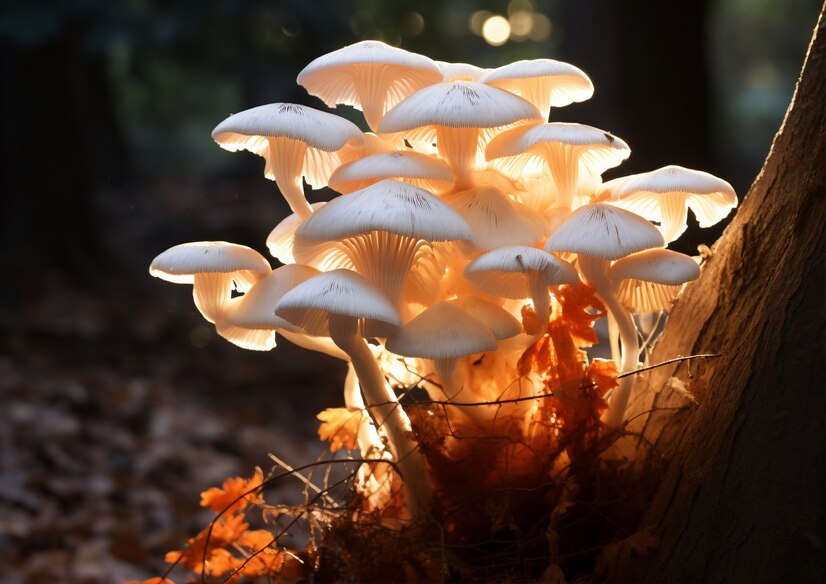FOOD
Exploring Nutritious Options Beyond the Traditional

Over the past few years, eating right and achieving proper health have been increasingly talked about and taken seriously. Looking at the broader picture, as individuals are becoming more and more health-conscious and understand that their diet can affect their health and well-being positively or negatively; there is growing belief in discovering healthy options outside that which has been considered ‘standard fare’. The objective of this writing is to examine how this dynamic nutrition domain shifts over time and explain how we should diversify our diet and make it more varied to reach optimum health outcomes.
Diversifying Nutritional Intake
Typical dietary patterns commonly involve foods that are part of the traditional culture and whose history involves little alterations and lack to this day of ready availability. While staple foods can provide essential nutrients, relying solely on them can lead to nutritional deficiencies. That is to say, they could lead to deficiencies in nutrients other than those that are meant for overall health. Therefore, the consumption of a variety of foods is encouraged to promote a balanced dietary regimen.
One direction for diversification may be in the development of multiple types of fruits and vegetables including the unwelcome ones for some and the local or specifically for some certain areas. For example, incorporating dragon fruit, kiwi, and star fruit—often considered exotic—can introduce a variety of flavors and provide a wider range of vitamins, micronutrients, and antioxidants to one’s diet. Alternatively, incorporating heirloom varieties of foraged wild greens into the ingredients can enhance both the taste and nutrient content of dishes like baked oats in the air fryer.
However, diversifying plant-based foods extends beyond fruits and vegetables to include various sources of protein. However, although animal products still are the main part of the protein intake of many people, there is a growing interest in plant proteins and alternative sources of protein. Honestly, when it comes to protein, legumes, nuts, seeds, and old grains such as quinoa and amaranth are some of the best foods available, and not only do they provide quality nutrition but also sustainability and a friendly environment to our surroundings. As you look for creative ways of incorporating these nutritious options in your diet, consider experimenting with recipes like air fryer oatmeal for a delightful twist on a classic breakfast favorite.
Functional Foods and Superfoods Investigations
Another trend that is seen to influence the dietary decisions of consumers is the increased attraction to functional products and superfoods which are foods that are known or believed to offer health benefits that go beyond fundamental nutrition. Many green foods are rich in antioxidants, phytochemicals, bioactive compounds, and proteins, which are known to support overall health and protect against chronic diseases.
One effective category of functional food is fermented food in which the microorganisms are bacteria or yeast that are beneficial for health. For instance, foods are cabbage, garlic, yogurt drinks, and fermented tea. Fermented foods can enhance the flavor of the food as well as the digestibility, while they provide probiotics that are good for the two functions of the health and the immune system.
Lastly, superfoods such as berries, leafy greens, and nuts, known for their nutrient density and health benefits, are also frequently discussed. Virtually, blueberries are one of the best fruits to protect individuals against diseases that cause aging such as oxidative stress due to their high antioxidant content. In the same way, collards and kale are superfoods that contain the highest quantities of vitamins, minerals, and phytochemicals which we need to be active and healthy.
Embracing Alternative Diets
Redefining nutrition is crucial not only for inclusion but also for exploring non-traditional options that prioritize health, sustainability, and ethical considerations. One of the methods for the halting and even reversal of the American trend to the `Western diet’ is eating foods from the Mediterranean. These foods are mostly plant-based, having a moderate amount of healthy fats (like olive oil), lean proteins (like fish, legumes), and low wine consumption. Individuals who adhere to the characteristics of the Mediterranean diet have a lower risk of heart disease, stroke, and dementia, as demonstrated by numerous surveys in various studies..
Now, one of the many growing dietary trends is plant-based or veganism which is essentially the exclusion of animal products from the diet, instead of looking at plant-based foods. The plant-based diets have been celebrated for their promise of improved health, and it has now been associated with reduced rates of obesity, hypertension, and a few kinds of cancers. Additionally, plant-based diets like baked oats recipes exhibit a lesser ecological footprint as they meagrely consume natural resources and generate trace greenhouse gasses in comparison to the style of meat-based diets widely adopted.
Along with individual dietary decisions, holistic nutrition where mind, body, and spirit are aligned is trending toward well-being. Mindful eating techniques such as being aware of hunger cues, savoring the food, and cultivating the attitude of thanks for each part of food you eat will lead to the real realization of connection with food and to the most healthy mindset of eating.
Challenges and Considerations
The unearthing of the nutritional options that go beyond the typical ones promises excellent outcomes for health results; however, there is also the possibility of having several hurdles and considerations to face along the line. Accessibility to a variety of foods especially in food-deserted communities is one of the challenges limiting many people from making a positive shift in their dietary habits. Imagining the food insecurity issue and making equitable access to nutritious foods are the key causes of supporting healthier communities.
Another element is that they have to sift through the conflicting reports on nutrition “research” and dieting, and they do so too quickly to find trustworthy guidance on proper nutrition. Critical thinking and decision-making on an evidence-based approach are vital when knowing reliable sources of nutrition information. These skills will be able to help you also with distinguishing between hype and scientific evidence.
Alternative Protein Sources
Alternative Protein Sources | Description | Examples |
Legumes | Rich in protein, fiber, and essential nutrients. | Beans, lentils, chickpeas |
Nuts | High in protein, healthy fats, and micronutrients. | Almonds, peanuts, walnuts |
Seeds | Packed with protein, omega-3 fatty acids, and minerals. | Chia seeds, flaxseeds, pumpkin seeds |
Ancient Grains | Nutrient-dense grains with higher protein content. | Quinoa, amaranth, teff |
Conclusion
Therefore, nutritional adventures beyond the conventional are being taken toward a route of comprehensive health that ensures a variety of nutritional practices, uses functional foods as well as phytochemicals-rich foods, and also takes into account dietary alternatives that are linked to good health, environmental sustainability, and ethical considerations. While we enjoy tasting different food items, we also nurture the mind and planate and give a new perspective on food. While we are exploring shifts in nutrition that are a result of a constantly changing environment, let us always be open-minded, curious, and self-empowered to make knowledgeable choices which in turn guarantees our well-being as well as that of future generations.
FAQs
What are functional foods?
Functional food is defined as food that contributes to overall well-being beyond basic nutrition. This is achieved through the presence of highly beneficial bioactive compounds such as antioxidants and probiotics that support the body.
How does one define what a superfood is, as well as why do people go for these foods?
Superfoods are characterized by their nutrient-dense nature, as they are rich in vitamins, minerals, and antioxidants, which are believed to boost immunity and reduce the risk of chronic diseases.
How does the Mediterranean diet differ from others, and why is it considered better?
The Mediterranean diet primarily consists of fruits, vegetables, whole grains, healthy fats, and lean protein, with olive oil being the primary source of healthy fats. Additionally, moderate consumption of wine is encouraged for protein intake. It is positively linked with lower chances of the occurrence of diseases such as myocardial infarction, stroke, and dementia.
FOOD
Ever heard of the Baby Food Autism Lawsuit? Read All About it Here!

Recent reports have raised alarm over the presence of heavy metals like lead, arsenic, and mercury in baby food products, sparking widespread concern among parents. These contaminants have been linked to serious health risks, including developmental disorders such as autism.
In response, numerous lawsuits have been filed against major baby food companies, alleging negligence and demanding stricter safety standards. If you are seeking representation, it is crucial to consult the best product liability attorneys to navigate the complexities of these legal battles effectively.
Legal representation aside, it also helps to stay updated on the current status of the lawsuit. Dedicated lawsuit websites help in this regard. Lawsuit Legal News is one such website that contains everything you need to know about class action lawsuits in the US. The pages are also updated regularly to make sure plaintiffs or the general public know the current status of the class action lawsuit.
This article aims to provide a comprehensive overview of the ongoing baby food lawsuit and how parents can protect their children from potential harm.
The Rise of Baby Food Lawsuits
The baby food lawsuits began gaining attention in March 2021 after a shocking Congressional report revealed high levels of heavy metals in many popular baby food brands. This report sparked concern among parents and led to a wave of legal actions against baby food manufacturers.
Since the report’s release, around 60 lawsuits have been filed by parents who believe their children’s health has been harmed by these contaminated products. The lawsuits target major baby food companies, accusing them of negligence and failure to ensure the safety of their products.
Some of the early cases were dismissed due to a lack of evidence directly linking the heavy metals to specific health issues in children. However, the growing number of lawsuits highlights the widespread concern and demand for accountability from these companies.
What are the Allegations?
The lawsuits allege that baby food companies knowingly sold products contaminated with high levels of heavy metals, including lead, arsenic, cadmium, and mercury. These contaminants have been found in a variety of baby foods, including rice cereals, purees, and snacks.
Exposure to these heavy metals has been linked to serious health issues such as cancer, organ damage, and developmental disorders like autism. Parents claim that their children have suffered from these health problems after consuming these contaminated products.
Science and the Lawsuit
While there is no definitive evidence linking heavy metal exposure to autism or other developmental disorders, numerous studies have found a correlation between exposure to these contaminants and negative health effects.
For example, a 2020 study by Healthy Babies Bright Futures found that nearly all baby foods tested contained at least one heavy metal. Additionally, the report stated that long-term exposure to high levels of these metals can lead to serious health problems in children.
Despite this strong scientific evidence, proving a direct link between contaminated baby food products and specific health issues in children may be challenging in court. This is where experienced product liability lawyers can help build a strong case and fight for justice on behalf of affected families.
Current Status of the Lawsuits
As the lawsuits continue to gain momentum, baby food companies are facing increasing pressure to address these concerns and take action to ensure the safety of their products.
In response, some manufacturers have announced plans to reduce heavy metal levels in their products over time. However, many parents are calling for immediate action and stricter safety standards.
The lawsuits are still ongoing, with no clear resolution in sight. It is essential for parents to stay informed about any updates or developments in this legal battle and consult an attorney if they believe their child has been affected by contaminated baby food products.

What Parents Can Do
As the lawsuits continue to unfold, parents can take some steps to protect their children from potential harm. These include:
- Being cautious when introducing new foods into their baby’s diet and opting for organic or homemade options whenever possible.
- Staying updated on any product recalls or safety warnings issued by the FDA or individual manufacturers.
- Keeping an eye out for any symptoms of heavy metal exposure in their child, such as developmental delays, irritability, and digestive issues.
- Seeking medical attention if they suspect their child has been exposed to heavy metals and documenting any potential health issues.
Ultimately, it is the responsibility of baby food companies to ensure the safety of their products. However, parents can also take proactive measures to protect their children from potential harm.
FOOD
Brosé: The Rise of Rosé for Men and the Culture Behind It

Introduction
Move over, beer and whiskey—there’s a new drink in town, and it’s pink! Brosé, the playful term for rosé wine embraced by men, is more than just a fad. It’s a cultural shift that challenges traditional gender norms and celebrates the universal appeal of this delightful wine. So, what exactly is brosé, and why are men all over the world raising their glasses to it?
What is Brosé?
Brosé is simply rosé wine enjoyed by men, breaking away from the outdated notion that pink drinks are only for women. This trend celebrates the versatility and refreshing nature of rosé, making it a staple at summer gatherings, rooftop parties, and casual get-togethers. Unlike traditional rosé, which has often been marketed towards women, brosé is all about inclusivity and enjoying good wine without stereotypes.
History of Rosé Wine
Rosé wine has a rich history that dates back thousands of years. Originating in the Mediterranean regions, it was one of the earliest forms of wine produced. Over the centuries, rosé has evolved, gaining popularity in regions like Provence, France, known for its high-quality pink wines. In recent years, rosé has seen a surge in popularity, transcending cultural and gender boundaries.
The Emergence of Brosé
The brosé trend began gaining traction in the mid-2010s, coinciding with the rise of social media and lifestyle influencers. Events like National Rosé Day and popular culture references helped catapult rosé into the spotlight, with men increasingly joining the rosé revolution. Influential figures and celebrities, such as rappers and actors, openly enjoying rosé have also played a significant role in normalizing the trend.
Why Men are Embracing Rosé
Men are embracing rosé for several reasons. Firstly, it’s a refreshing and versatile wine that pairs well with various foods and occasions. Secondly, the shift towards more open and inclusive gender norms has encouraged men to enjoy rosé without fear of judgment. The pink wine’s light and crisp profile make it an excellent choice for warm weather and casual settings, further adding to its appeal.
Marketing and Branding
The marketing of brosé has been key to its success. Brands have cleverly targeted male consumers with bold, masculine packaging and campaigns that highlight the wine’s sophistication and versatility. Taglines like “Real men drink pink” and endorsements from male celebrities have further helped in rebranding rosé as a drink for everyone.
The Social Aspect of Brosé
Brosé has become a social phenomenon, prominently featured at parties, beach outings, and barbecues. Social media platforms like Instagram and TikTok have amplified the trend, with hashtags like #brosé and #roséallday showcasing men enjoying their favorite pink wine. This social aspect has helped foster a community of brosé enthusiasts who share their experiences and recommendations online.
Brosé and Food Pairing
One of the joys of rosé is its versatility in food pairings. Brosé pairs exceptionally well with a variety of dishes, from light salads and seafood to grilled meats and spicy cuisines. Its acidity and fruity notes complement a wide range of flavors, making it a perfect match for almost any meal.
Brosé Festivals and Events
Brosé-themed festivals and events have sprung up around the world, celebrating this beloved wine. Events like the La Nuit en Rosé festival in New York and the Rosé Mansion in Los Angeles offer immersive experiences for rosé lovers, complete with tastings, food pairings, and live entertainment. These events highlight the communal and festive nature of brosé culture.
Brosé in Pop Culture
Rosé has made its mark in pop culture, with numerous references in movies, music, and TV shows. Celebrities often share their love for rosé on social media, further embedding it into popular culture. From music videos to lifestyle blogs, brosé is frequently featured as a trendy and sophisticated choice.
Health Benefits of Rosé
Moderate consumption of rosé, like other wines, may offer certain health benefits. Rich in antioxidants, rosé can contribute to heart health and reduce inflammation. Its lower calorie content compared to other alcoholic beverages also makes it a more health-conscious choice for those watching their intake.
How to Choose a Good Rosé
Selecting a quality rosé can enhance your brosé experience. Look for wines from reputable regions known for their rosé, such as Provence, France. Check the vintage and opt for recent years to ensure freshness. Recommendations from wine experts and sommeliers can also guide you in choosing a rosé that suits your palate.
DIY Brosé Cocktails
Brosé isn’t just for sipping straight—it also makes a fantastic base for cocktails. Popular brosé cocktails include frosé (frozen rosé), rosé sangria, and rosé spritzers. These refreshing drinks are perfect for summer gatherings and add a creative twist to your rosé experience. Experiment with fruit garnishes, herbs, and even a splash of spirits to create your own signature brosé cocktail.
The Future of Brosé
The brosé trend shows no signs of slowing down. As societal norms continue to evolve and the appreciation for rosé grows, we can expect to see even more innovative products and events centered around brosé. The future holds exciting possibilities for new rosé varieties, creative marketing strategies, and expanded acceptance of this delightful wine.
Conclusion
Brosé represents a significant cultural shift towards inclusivity and breaking down gender stereotypes in the world of wine. Its rise in popularity highlights a growing appreciation for rosé’s unique qualities and the joy of sharing good wine with friends, regardless of gender. As brosé continues to make its mark, it promises to remain a beloved part of social and culinary experiences.
FAQs
- What exactly is brosé?
Bro-sé is a playful term for rosé wine that is enjoyed by men, challenging the stereotype that pink drinks are only for women. - How did bro-sé become popular?
Bro-sé gained popularity through social media, influential figures openly enjoying rosé, and cultural events that celebrated the wine, making it trendy and socially acceptable for men. - What are some good food pairings with brosé?
Bro-sé pairs well with a variety of foods, including salads, seafood, grilled meats, and spicy dishes, thanks to its refreshing acidity and fruity notes. - Are there health benefits to drinking bro-sé?
Moderate consumption of bro-sé, like other wines, may offer health benefits such as heart health and reduced inflammation due to its antioxidant content. - How can I make bro-sé cocktails at home?
Popular bro-sé cocktails include frosé, rosé sangria, and rosé spritzers. You can create your own by mixing rosé with fruits, herbs, and spirits to suit your taste.
FOOD
Exploring A Field Guide to Ecuadorian Mushrooms

Introduction to Ecuadorian Mushrooms
Ecuador is a land of stunning biodiversity, where lush rainforests cradle an array of unique flora and fauna. Among these treasures lie Ecuadorian mushrooms—fascinating organisms that thrive in the region’s rich ecosystems. From vibrant edible varieties to mysterious fungi with potent medicinal properties, these mushrooms are more than just a culinary delight; they are woven into the cultural fabric of Ecuador.
Exploring this world can be both enchanting and enlightening. Whether you’re a seasoned forager or simply curious about what lies beneath the forest canopy, understanding A Field Guide to Ecuadorian Mushrooms species opens up new pathways for exploration, creativity, and sustainability. Dive into this field guide as we embark on a journey through Ecuadorian mushrooms—from their diverse types to their role in traditional practices—and discover recipes that celebrate their flavors along the way.
Common Types of Mushrooms Found in Ecuador
Ecuador is a treasure trove of mushroom diversity, thanks to its varied ecosystems. Among the most common types are the vibrant Chanterelles. These golden-hued beauties boast a delicate flavor and are often found in moist, forested areas.
Another notable variety is the Shiitake mushroom. Valued for its rich, umami taste, it’s commonly cultivated but also thrives in wild habitats across Ecuador’s highlands.
The Porcini mushroom stands out with its robust flavor and meaty texture. Foragers love searching for these under conifers and hardwoods during rainy seasons.
Don’t overlook the medicinal Reishi mushrooms either. Known for their health benefits, these fungi can be spotted on decaying wood throughout lush landscapes.
Each type showcases Ecuador’s unique ecological charm while tempting chefs and food enthusiasts alike with endless culinary possibilities.
Foraging and Safety Tips
Foraging for mushrooms in Ecuador can be a rewarding adventure, but safety should always come first. Familiarize yourself with the local species before heading into the wild. Some mushrooms are edible, while others can be toxic or even deadly.
Invest time in studying field guides or joining local foraging groups. Learning from experienced foragers will enhance your knowledge and confidence when identifying various types of fungi.
Always carry a basket instead of plastic bags to allow spores to spread as you forage. This simple practice helps sustain ecological balance.
Before consuming any mushroom, conduct a spore print test. This technique involves placing the cap on paper overnight to reveal its unique spore color. If unsure about a find, it’s best to err on the side of caution—never eat anything you’re not completely sure is safe.
Keep an eye out for environmental changes too; some areas may have pesticides that could contaminate wild mushrooms.
Traditional Uses of Mushrooms in Ecuadorian Culture
Mushrooms hold a special place in Ecuadorian culture, woven into the fabric of ancient traditions and modern practices. Indigenous communities have long recognized their medicinal properties, using various species to treat ailments ranging from respiratory issues to digestive troubles.
In rituals and ceremonies, mushrooms are often seen as sacred. They symbolize connection to nature and spirituality. Some tribes incorporate them into healing rites, believing they enhance spiritual journeys.
Culinary uses abound as well. Traditional dishes feature local mushrooms that add depth and flavor. From hearty stews to simple sautés, these fungi elevate everyday meals with rich tastes.
Moreover, knowledge about mushroom foraging is passed down through generations. This fosters a deep respect for nature’s bounty while promoting sustainable harvesting practices within communities across the country. Such cultural richness showcases the integral role of mushrooms beyond mere sustenance or medicine—acting instead as vital components of identity and heritage.
Culinary Delights: Recipes Using Ecuadorian Mushrooms
Ecuadorian mushrooms bring a unique flavor to various dishes. Their earthy tones and varied textures can elevate even the simplest of meals.
One delightful recipe is mushroom ceviche. Combine finely chopped fresh Ecuadorian mushrooms with lime juice, red onion, cilantro, and a hint of chili for a refreshing twist on this classic dish. Serve it chilled for an appetizer that’s sure to impress.
Another option is mushroom soup made from local varieties like champiñones or shiitake. Sauté onions and garlic in olive oil, then add sliced mushrooms and vegetable broth. Simmer until tender and blend until creamy for a comforting bowl of goodness.
For those who enjoy pasta, sautéing Ecuadorian mushrooms with garlic and herbs creates an irresistible sauce. Toss it with your favorite noodles for an easy yet gourmet meal that highlights the wonderful flavors these fungi offer.
Experimenting with different types will unveil new culinary experiences full of surprises!
The Role of Mushrooms in Sustainable Farming Practices
Mushrooms play a crucial role in sustainable farming. They naturally break down organic matter, enhancing soil health and fertility. This decomposition process enriches the earth, allowing other plants to thrive.
Farmers have begun integrating mushrooms into crop rotation systems. Their ability to improve soil structure supports better water retention and nutrient availability. As a result, this practice reduces the need for chemical fertilizers.
Mycorrhizal fungi form beneficial partnerships with plant roots. These relationships enhance nutrient uptake while significantly reducing erosion risks. Thus, farms become more resilient against harsh weather conditions.
Moreover, mushroom cultivation can utilize agricultural waste products like straw or sawdust. This not only minimizes waste but also diversifies farmers’ income streams by tapping into local markets for fresh mushrooms.
Embracing fungi in agriculture creates a healthier ecosystem while promoting biodiversity on farms across Ecuador and beyond.
Conclusion: A Field Guide to Ecuadorian Mushrooms
A Field Guide to Ecuadorian Mushrooms are a fascinating component of the country’s rich biodiversity. They offer unique flavors and nutritional benefits that can elevate any dish.
Foraging for these fungi is not just an adventure; it’s a way to connect with nature. It promotes awareness about local ecosystems and encourages sustainable practices.
Mushrooms also play a significant role in Ecuador’s culture, from traditional medicine to celebrations. Their incorporation into local cuisine showcases the creativity of Ecuadorian chefs.
As interest in sustainable farming grows, mushrooms stand out as valuable allies in promoting soil health and biodiversity. They remind us that every ingredient has its place in creating a balanced ecosystem.
Exploring this world opens doors to new tastes and experiences, highlighting the importance of preserving such treasures for future generations. Embrace your curiosity, dive deeper into mushroom exploration, and enjoy all that Ecuador has to offer!
FAQs
- What types of mushrooms are commonly found in Ecuador?
Ecuador is home to a wide variety of mushrooms. Some popular species include the Chanterelle, Porcini, and Shiitake. Each type has its unique flavor profile and characteristics.
- Are there any poisonous mushrooms in Ecuador?
Yes, there are toxic varieties present. It’s crucial to educate yourself about which ones to avoid. Always consult an expert or use reliable field guides before foraging.
- How can I safely forage for mushrooms in Ecuador?
Start by learning from experienced foragers or joining local mushroom hunting groups. Bring along a guidebook or app that helps identify edible varieties. Avoid areas near roads or polluted sites.
- What role do mushrooms play in traditional Ecuadorian cuisine?
Mushrooms are often used in soups, stews, and various dishes throughout Ecuadorian culture. They add depth and richness to meals while also providing nutritional benefits.
- Can you recommend any specific recipes featuring Ecuadorian mushrooms?
Absolutely! Try making a flavorful Mushroom Ceviche with fresh citrus juices or a hearty Mushroom Risotto infused with local spices for a delicious twist on classic dishes.
- How do mushrooms contribute to sustainable farming practices in Ecuador?
Mushrooms improve soil health by breaking down organic matter and enriching it with nutrients. They also offer farmers an additional source of income through cultivation alongside other crops.
- Is mushroom farming viable as an income source in rural areas?
Yes! Many small-scale farmers have successfully integrated mushroom cultivation into their operations, benefiting both their families and local economies while promoting biodiversity.

 Cartoon5 months ago
Cartoon5 months agoUnlocking the Potential of Nekopoi.care: A Comprehensive Guide

 Game4 months ago
Game4 months agoExploring Aopickleballthietke.com: Your Ultimate Pickleball Destination

 BUSINESS4 months ago
BUSINESS4 months agoWhat Companies Are In The Consumer Services Field

 HEALTH5 months ago
HEALTH5 months agoUnveiling the Mystery of Pikruos: A Comprehensive Guide

 HOME IMPROVEMENT5 months ago
HOME IMPROVEMENT5 months agoExploring the Events of 2023-1954: A Look Back in Time

 TECHNOLOGY4 months ago
TECHNOLOGY4 months agoUnderstanding Coomersu

 FASHION4 months ago
FASHION4 months ago5 Reasons Why Every Woman Needs a Long Sleeve Dress in Her Closet

 ENTERTAINMENT5 months ago
ENTERTAINMENT5 months agoThe Epic Return: Revenge of the Iron-Blooded Sword Hound
















